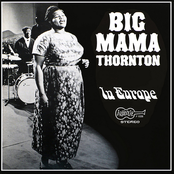In Europe

Biography
Big Mama Thornton (Willie Mae Thornton, December 11, 1926, Montgomery, AL - July 25, 1984, Los Angeles, CA) was an American blues musician. Her introduction to music, as with most fellow blues legends, started in the Baptist church. The daughter of a minister, she and her six siblings began to sing at a very early age. While still a child, Willie Mae taught herself to play the drums and harmonica, and by the age of 14, she had run away from home to make her career in secular music. She joined...
Big Mama Thornton (Willie Mae Thornton, December 11, 1926, Montgomery, AL - July 25, 1984, Los Angeles, CA) was an American blues musician.
Her introduction to music, as with most fellow blues legends, started in the Baptist church. The daughter of a minister, she and her six siblings began to sing at a very early age. While still a child, Willie Mae taught herself to play the drums and harmonica, and by the age of 14, she had run away from home to make her career in secular music.
She joined Sammy Green's "Hot Harlem Revue" and toured throughout the South in the 1940's, first beginning her musical career in 1947. While touring Texas in 1948, Thornton left the Revue in favor of the state's growing club scene, which she immersed herself in. It was during this time that she was discovered by Don Robey, a black entrepreneur who owned several clubs and record stores in the Houston, TX area. Impressed by her massive size (6 ft, 350+ lb),formidable multi-instrument abilities, and fiery stage presence, Robey signed her to his Peacock Records label, where he began the task of translating the forceful belter's energy onto record.
Her big hit came, not from Robey's capable pen, but from the young songwriting team of Jerry Leiber and Mike Stoller. It was "Hound Dog," which she recorded in 1953 with the Johnny Otis band. Big Mama Thornton always claimed to have written the song herself (a claim which may actually hold some validity), and her ferocious rendition of it ( complete with Big Mama's growl and a nasty guitar line by Pete Lewis) held the #1 spot in the Billboard rhythm and blues charts for nine weeks. Unfortunately for Thornton, Elvis Presley's smoother and bowdlerized version was a major pop hit in 1956 and successfully eclipsed her biggest claim to fame.
Thornton continued to tour the "chitlin' circuit" as fans began to favour newer R&B sounds over blues. For some years, Big Mama suffered in obscurity like most of her fellow bluesmen. Her name gained wider prominence and her career enjoyed a significant resurgence as her song "Ball and Chain" was covered by Janis Joplin, making it a regular number in her repertoire. From that point onward, Thornton would remain a headliner at blues festivals, colleges, and clubs throughout the country and even in Europe. She began recording again, and released albums for the Arhoolie, Mercury, and Vanguard labels. Years of hard drinking and living began to take their toll, however, and by the late 1970s her health (and her trademark girth) had declined greatly. She nevertheless performed until her death at the age of 57 on July 25, 1984 in Los Angeles, where she was found dead from natural causes in the boarding house room in which she had been living. Johnny Otis conducted her funeral services, and she was laid to rest in Inglewood Park Cemetery. Read more on Last.fm. User-contributed text is available under the Creative Commons By-SA License; additional terms may apply.
